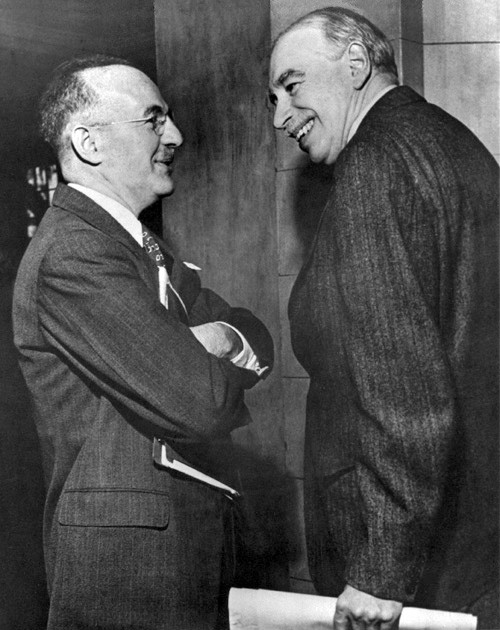Monetarism Wikipedia the free encyclopedia
Post on: 29 Сентябрь, 2015 No Comment

In monetary economics. monetarism is a school of thought that emphasizes the role of governments in controlling the amount of money in circulation. Monetarists believe that variation in the money supply has major influences on national output in the short run and the price level over longer periods, and that objectives of monetary policy are best met by targeting the growth rate of the money supply rather than by engaging in discretionary monetary policy. [ 1 ]
Contents
§ Description [ edit ]
Monetarism is an economic theory that focuses on the macroeconomic effects of the supply of money and central banking. Formulated by Milton Friedman. it argues that excessive expansion of the money supply is inherently inflationary. and that monetary authorities should focus solely on maintaining price stability.
This theory draws its roots from two historically antagonistic schools of thought: the hard money policies that dominated monetary thinking in the late 19th century, and the monetary theories of John Maynard Keynes. who, working in the inter-war period during the failure of the restored gold standard. proposed a demand-driven model for money. [ citation needed ] While Keynes had focused on the value stability of currency, with the resulting panics based on an insufficient money supply leading to alternate currency and collapse, then Friedman focused on price stability, which is the equilibrium between supply and demand for money.
The result was summarized in a historical analysis of monetary policy, Monetary History of the United States 1867–1960. which Friedman coauthored with Anna Schwartz. The book attributed inflation to excess money supply generated by a central bank. It attributed deflationary spirals to the reverse effect of a failure of a central bank to support the money supply during a liquidity crunch. [ citation needed ]
Friedman originally proposed a fixed monetary rule. called Friedman’s k-percent rule. where the money supply would be automatically increased by a fixed percentage per year. Under this rule, there would be no leeway for the central reserve bank as money supply increases could be determined by a computer, and business could anticipate all money supply changes. [ 3 ] [ 4 ] With other monetarists he believed that the active manipulation of the money supply or its growth rate is more likely to destabilize than stabilize the economy.
§ Opposition to the gold standard [ edit ]
Most monetarists oppose the gold standard. Friedman, for example, viewed a pure gold standard as impractical. [ 5 ] For example, whereas one of the benefits of the gold standard is that the intrinsic limitations to the growth of the money supply by the use of gold or silver would prevent inflation, if the growth of population or increase in trade outpaces the money supply, there would be no way to counteract deflation and reduced liquidity (and any attendant recession) except for the mining of more gold or silver under a gold or silver standard.
§ Rise [ edit ]
Clark Warburton is credited with making the first solid empirical case for the monetarist interpretation of business fluctuations in a series of papers from 1945. [ 1 ] p. 493 Within mainstream economics, the rise of monetarism accelerated from Milton Friedman ‘s 1956 restatement of the quantity theory of money. Friedman argued that the demand for money could be described as depending on a small number of economic variables. [ 6 ]
Thus, where the money supply expanded, people would not simply wish to hold the extra money in idle money balances; i.e. if they were in equilibrium before the increase, they were already holding money balances to suit their requirements, and thus after the increase they would have money balances surplus to their requirements. These excess money balances would therefore be spent and hence aggregate demand would rise. Similarly, if the money supply were reduced people would want to replenish their holdings of money by reducing their spending. In this, Friedman challenged a simplification attributed to Keynes suggesting that money does not matter. [ 6 ] Thus the word ‘monetarist’ was coined.
The rise of the popularity of monetarism also picked up in political circles when Keynesian economics seemed unable to explain or cure the seemingly contradictory problems of rising unemployment and inflation in response to the collapse of the Bretton Woods system in 1972 and the oil shocks of 1973. On the one hand, higher unemployment seemed to call for Keynesian reflation. but on the other hand rising inflation seemed to call for Keynesian disinflation .
In 1979, President Jimmy Carter appointed a Federal Reserve chief Paul Volcker. who made inflation fighting his primary objective, and restricted the money supply (in accordance with the Friedman rule ) to tame inflation in the economy. The result was the creation of the desired price stability.
Monetarists not only sought to explain present problems; they also interpreted historical ones. Milton Friedman and Anna Schwartz in their book A Monetary History of the United States, 1867–1960 argued that the Great Depression of 1930 was caused by a massive contraction of the money supply and not by the lack of investment Keynes had argued. They also maintained that post-war inflation was caused by an over-expansion of the money supply.
They made famous the assertion of monetarism that ‘inflation is always and everywhere a monetary phenomenon’. Many Keynesian economists initially believed that the Keynesian vs. monetarist debate was solely about whether fiscal or monetary policy was the more effective tool of demand management. By the mid-1970s, however, the debate had moved on to other issues as monetarists began presenting a fundamental challenge to Keynesianism.
Many monetarists sought to resurrect the pre-Keynesian view that market economies are inherently stable in the absence of major unexpected fluctuations in the money supply. Because of this belief in the stability of free-market economies they asserted that active demand management (e.g. by the means of increasing government spending) is unnecessary and indeed likely to be harmful. The basis of this argument is an equilibrium between stimulus fiscal spending and future interest rates. In effect, Friedman’s model argues that current fiscal spending creates as much of a drag on the economy by increased interest rates as it creates present consumption: that it has no real effect on total demand, merely that of shifting demand from the investment sector (I) to the consumer sector (C).
When Margaret Thatcher. leader of the Conservative Party in the United Kingdom. won the 1979 general election defeating the incumbent Labour Party led by James Callaghan. Britain had endured several years of severe inflation. which was rarely below 10% and by the time of the election in May 1979 stood at 10.3%. [ 7 ] Thatcher implemented monetarism as the weapon in her battle against inflation, and succeeded at reducing it to 4.6% by 1983.
James Callaghan himself had adopted policies echoing monetarism while serving as prime minister from 1976 to 1979, adopting deflationary policies and reducing public spending in response to high inflation and national debt. He initially had some success, as inflation was below 10% by the summer of 1978, although unemployment now stood at 1,500,000. However, by the time of his election defeat barely a year later, inflation had soared to 27%. [ 8 ]
§ Criticism [ edit ]
According to Alan Blinder and Robert Solow. [ 9 ] fiscal policy becomes impotent only when an interest-elasticity of the demand for money is zero. Empirically, such a perfect inelasticity does not occur. However, there are limited policy options when the interest rate is at or near the zero lower bound .

Although Milton Friedman [ 9 ] believed that wealth effects make deficit spending contractionary, Blinder and Solow believed that in reality fiscal stimulus is effective. To see this, they used a government budget constraint equation which includes interest on government bonds:
where B is the number of bonds whose face value per unit bond is 1 dollar. T is the tax function. In the long-run stationary state,
,
which gives
Immediately, it turns out that under money financing the fiscal multiplier becomes
because in this case . Both monetarists and Keynesians agree with the idea [ 9 ] that money-financed deficit spending has an expansionary impact on the economy. If deficits are financed by bonds, the long-run fiscal multiplier becomes larger than that by money-creation:
Thus their research shows that, in the long run, bond-financed government spending increases the income level more than money-financed deficit spending does.














